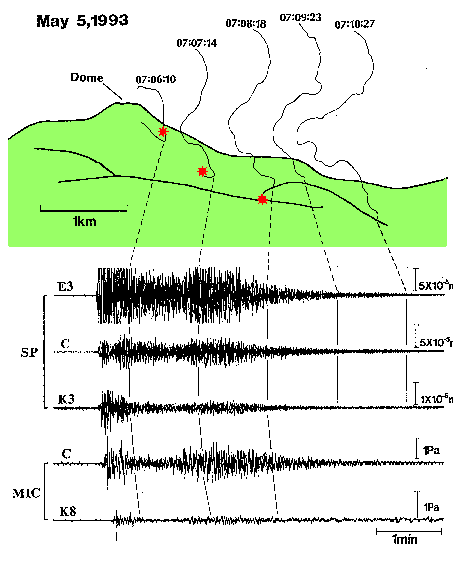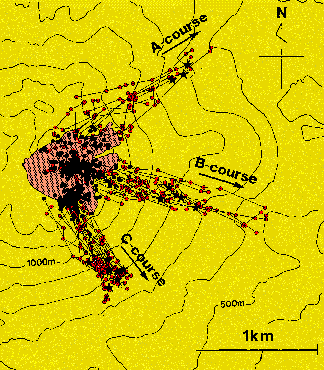Quantitative analysis of pyroclastic flows using infrasonic and seismic data
Japanese
The process of the collapse of the dacitic lava dome and the development of pyroclastic flows at Unzen volcano, Japan, were studied by using infrasonic, seismic and video records.
Characteristic infrasonic and seismic signals were recorded, corresponding to the collapse of lava blocks from the dome, the drop of blocks on the slope and the migration of pyroclastic flow on the mountain slope. Small infrasonic and seismic waves are excited when the lava dome starts to collapse. When the lava blocks fall onto the mountain slope and are fragmented, larger waves are excited. This suggests that the seismic waves are generated by the collision of pyroclastics onto the mountain slope and that the infrasonic waves are excited by small fracture of the dome and the fragmentation of pyroclastics.
Some of the infrasonic signals show an obvious Doppler effect, indicating that the pyroclastic flows emit infrasonic signals during their propagation. The location of dome collapse and the path of pyroclastic flows can be identified and traced by the network of low frequency microphones. The migrating source of infrasonic signals and probably seismic signals is inferred to be located near the front of pyroclastic flows by comparison with video images. This suggests that the fragmentation of pyroclastics occurs mainly near the front of pyroclastic flows. The speed of pyroclastic flows is estimated as 10-30 m/s from the infrasonic records.
The excitation of infrasonic and seismic signals is affected by the topography of the mountain slope. The infrasonic energy is almost the same order as the seismic energy but the energy ratio of infrasonic to seismic becomes larger for larger and more mobile pyroclastic flows. This means that the development of pyroclastic flows is controlled not only by volume of lava and gravitational force, but also by the explosivity related to the pore gases in the lava.

Illustration of the advancing pyroclastic flow and the corresponding seismic and infrasonic signals. The stars indicate the source locations of the infrasonic signals. Corresponding phases are indicated by lines. The descending of the pyroclastic flow is traced from the record of a time lapse video tape recorder.

Estimated source locations of the infrasonic signals from pyroclastic flows. Black circles indicate the sources due to dome collapses and red circles indicate the sources of later phases that arise from the flow of pyroclastics. The data from June 1992 to November 1993 are analyzed. The hatched area indicates the locus of the lava dome. Stars indicate the locations where the amplitudes of the later phases of the seismic and infrasonic signals reached a peak.
This paper is appared in Journal of Physics of the Earth (Vol. 45, pp. 397-416).
To Index

